Travel reviews by Mr S & Ms R from Surrey
Review Distribution
Total number of trips
1
Countries visited
2
Lodges stayed in
12
Excursions taken
1
Wonderful trip, marred by two theft incidents
Namibia and 1 other country between 29 Aug 2012 and 18 Sep 2012
The timing - late August to mid-September - was, we thought, perfect. There was spectacular whale-watching in Hermanus and we were able to visit the idyllic Postberg Nature Reserve (within the West Coast National Park), which is open only during the short spring-flower season. Temperatures generally were pleasant (though one needs to be prepared for cold spells - and rain interludes in the Cape) and the dry season in Etosha made for excellent game (but zero mosquito) viewing.
We suffered thefts on two occasions - one involving a hotel room safe in South Africa and the other a car break-in with damage, near Walvis Bay. These incidents (and their fall-out) dampened our spirits temporarily, but were outweighed by the pleasures experienced on each and every day. Overall, this trip ranks as one of our most enjoyable holidays in years of travelling."
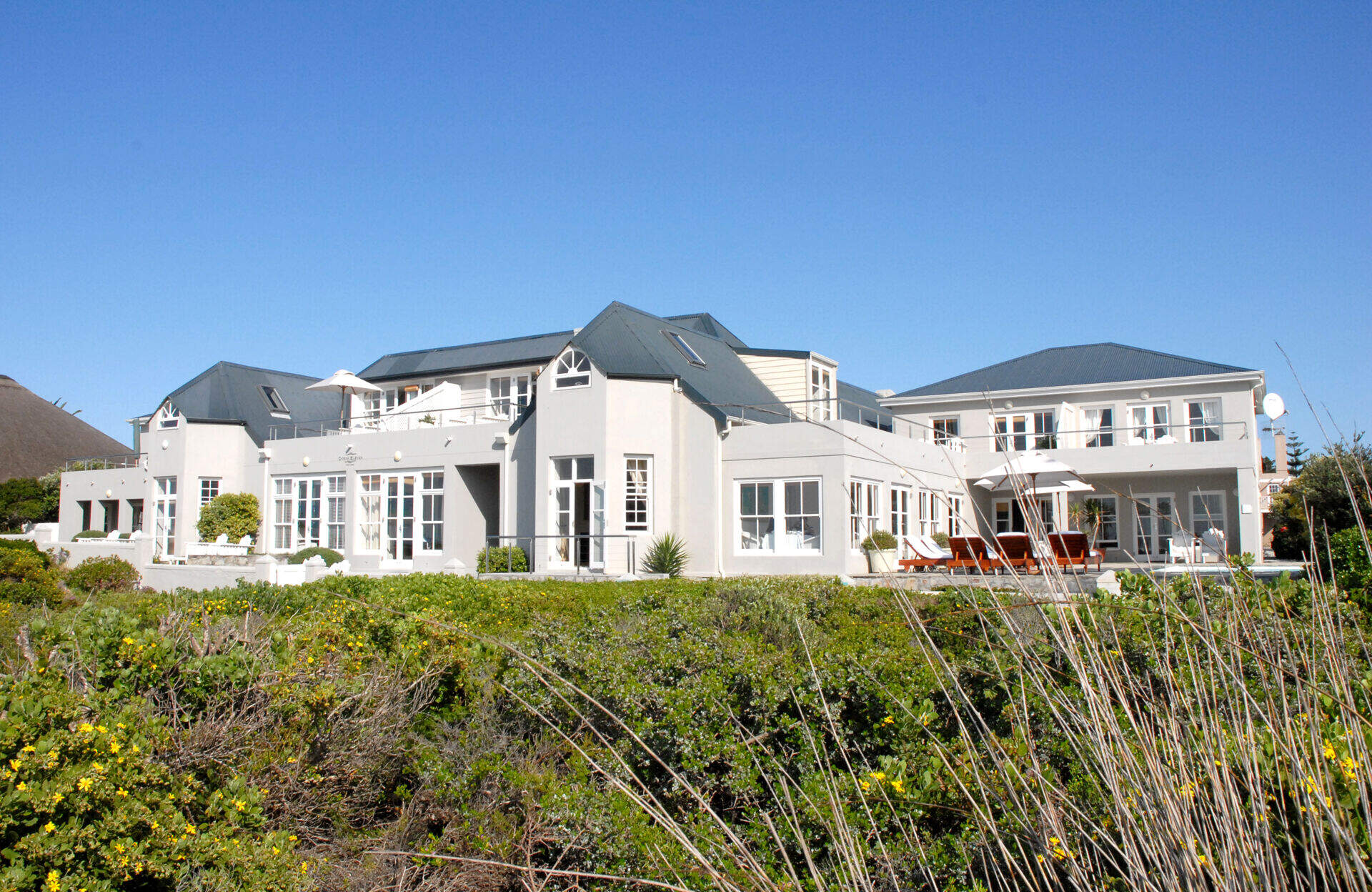
Ocean Eleven
"Beautiful stay, marred by suspected theft"
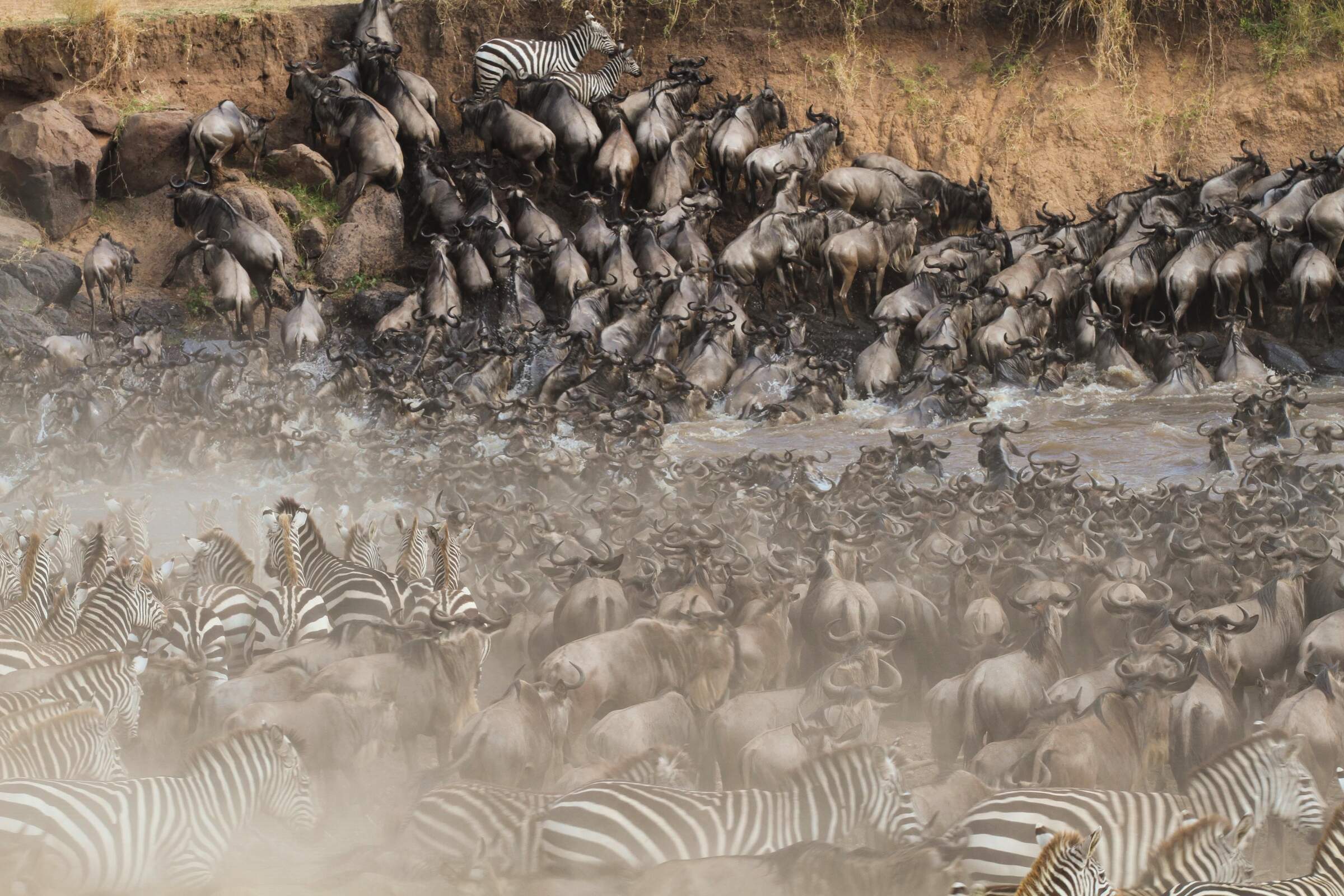
Constantia Uitsig, South Africa (this camp has since closed)
"Pleasant stay in wine-buff area"
The hotel is best placed for wine-buffs (which we are not) - various old vineyards and related tours are within easy reach, but these were of little interest to us (having a tight schedule and having sampled many vineyard operations before).
The remoteness of its location does push one to dine at the hotel after nightfall. On our first night, we ate in one of its two formal restaurants - good, straightforward food and service, but priced to reflect an ambiance which we were not seeking. Unfortunately, the hotel's River Cafe, which might have suited us better in the circumstances, was closed for maintenance during our stay. For our second dinner we decided to eat out (and can recommend the cheery Toad-on-the-Road gastropub, situated some 10-15 minutes drive south, towards Lakeside.
In order to help fit in a visit to Hermanus, we had cut short our stay in the Cape Town area to two nights - from the suggested three. This worked well for us and, for those who might be interested in a similar abbreviation, set out below is a summary of what we fitted in, aided by good luck with the weather.
Arrived Constantia at noon. Snacked at Hout Bay waterfront. Drove South via Chapman's Peak toll road (beautiful scenery). Visited Penguin colony at Simon's Town (penguins outnumbered by tourists). Down to foot of peninsula through baboon blockages. Climbed to Cape Point lighthouse (with many other tourists), visited Cape of Good Hope (much less crowded) and admired wild ostriches roaming around there (perhaps escapees from the ostrich farm, not visited). Back to hotel, with brief forays into Simon's Town and Fish Hoek en route. Following morning, drove to Tafelberg and parked near lower cable station. Up Table Mountain via cable-car (fares pre-paid online at small discount, to avoid first queue). Two hours on top doing circular walk, taking in the Eastern Table and Maclear's Beacon (fantastic views on walk, in all directions; crowds diminishing rapidly away from Western Table and cable car station). On descent, transferred to hop-on, hop-off city tour bus (fares prepaid online at small discount), departing every 20 minutes (car left, with no parking restrictions or charges, at Tafelberg). Two or three hour break from tour at V & A Waterfront for exploration and refuelling. Back to car at Table Mountain, late afternoon, via remainder of city tour, then return to hotel. Next morning, left Cape Town promptly for our trip north to Clanwilliam, taking in, en route, the West Coast National Park with its Postberg Nature Reserve (latter not to be missed, during its short opening for the two month wild flower season - stunning combination of flowers, plains-game, birds, sea, seals, hills, granite formations and lagoon, all less than 2 hours drive from the city)."
Not currently featured by Expert Africa

Ndedema Lodge
"Stimulating stop-over at Ndedema"
The owner, Wilma, had thoughtfully booked us a table at Emil's Place, a restaurant some 10 minutes walk back into Clanwilliam (fortunate for us, as we found the premises full and the dining excellent). We proceeded to have a good night's sleep in fine surroundings with all necessary facilities - followed by a hearty breakfast.
We had curtailed our stay at Clanwilliam to one night, in order to help fit in extra nights elsewhere. This worked well for us. On Wilma's recommendation the following morning, we briefly visited the Rooibos tea factory shop (which, strangely, had scarcely any of its products on sale - there was a better selection at the local SuperSpar).
She also recommended a brief side-trip into the Cedarberg Mountains, which was much more rewarding. We drove up the Pakhuis Pass and visited the poet, Leipoldt 's grave, with its overhang of bushmen's painting. Here we also encountered a large bunch of ageing Hell's Angel-style bike riders. With them and the backdrop of the monumental and eroded rock formations of the Cedarberg, we felt we had been transported to Arizona. We traveled a little further to take a look over the other side of the Pass, before - feeling fulfilled with what was on view - we retraced our steps.
We were back in Clanwilliam by 11.30am, only to find the Hog-riders hogging the town's sole petrol station. Nevertheless, we were well placed for the next stage of our journey towards Springbok, which we reached by around 3pm."

Old Mill Lodge, South Africa (this camp has since closed)
"Convenient stop-over at the Old Mill Lodge"
Immediately behind the lodge, and accessible from it, is a massive boulder, embedded in the side of a hill. It is reasonably easy to climb (in the dry) in rubber-soled shoes and, from some 50 metres above the premises, gives interesting views over much of the town.
In the evening, we walked to, and dined in, an unassuming bar-restaurant called El Dago, a couple of blocks away - where we had a satisfying meal with drinks at a surprisingly low price (equivalent to £15 with tip for the two of us).
Springbok, itself, felt like an outback town. The residents appeared fluent mainly in Afrikaans. Those we spoke with had some difficulty following our Brit-English, but were friendly and helpful. It has well-stocked shops - the last we were to see before reaching the Walvis Bay area of Nambia some six days later ( traveling, as we did, essentially along Expert Africa's Black Wildebeeste route).
As we first approached the town, we had detoured to visit the Goegab Nature Reserve, close by. We were not allowed to walk the circular hiking trail, which we had hoped for, as there was only one hour left before closure of the gates (at 16.00). Instead, we did the regular car circuit of about 20kms. Here we saw unusual mineral formations, springbok, oryx and stretches of wild flowers (though the latter collectively were not nearly as spectacular as those we had seen the day before, at the Postberg Nature Reserve). Worth a trip, we thought, if one has time to kill - but not a must-see."
Not currently featured by Expert Africa
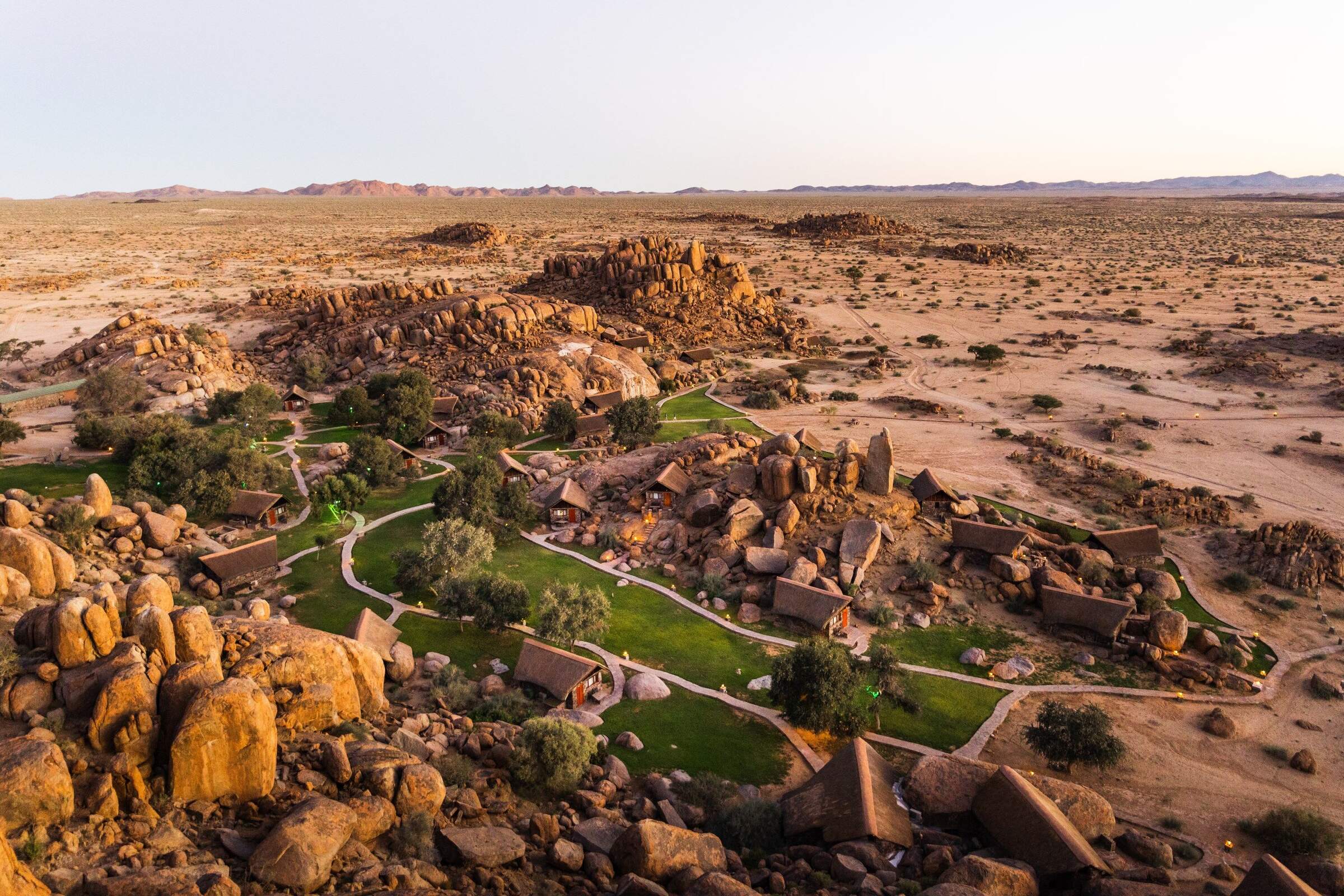
Canyon Lodge
"Fine hospitality at Canyon Lodge"
The property, as a whole, is like an oasis within its arid surrounds. It contains irrigated green lawns, fish pond, horse paddocks (with horses available for excursions), well-tended enclave of succulent (and other desert) plants and tastefully secluded swimming pool and bar, all surrounding a well-equipped central lodge.
Facilities generally were excellent for such a location. We were told that there was wi-fi internet access normally available, but that the wi-fi would be out of action during our stay. The Receptionist helpfully volunteered the use of the office inter-net connection, but even this had gone down on the second day - a situation not uncommon in Namibian locations so remote.
On our first evening, we joined the complimentary sundowner excursion. This took the form of a twenty minute guided walk from the lodge, up a nearby kopje - with a number of stops for commentary on fauna, flora and local geology by the knowledgeable party guide, Raymond. It culminated with beautiful views of the sunset from the top of the kopje and the supping of cocktails, conjured out of a convenient rock recess by the multi-skilled Raymond. Very enjoyable.
The buffet-style dinners were good. On learning that Anni was a vegetarian, the chef promised a special dish for her the following evening - and lived up to that promise in fine form. Diners remaining to the last (approx 9 pm) were treated to a five minute chorus of singing - from restaurant/ kitchen staff and the ubiquitous Raymond, who was also the wine waiter. This unannounced choir may well have been singing "Push off to bed and leave us in peace" in a local tongue - but the renditions were beautiful to hear and roundly applauded.
After breakfast on our first morning, we opted for a self-guided, circular hike of around 7kms, taking in what I will call "hole-in-the-wall". This unusual feature is a cliff-side aperture of about 3m diameter, near the top of a ridge. The latter lies across a small plain to the north of the lodge, from which the see-through hole is easily visible in morning light. The walk at this time of day was delightful. We encountered, among other things, springbok, kopje-dwelling dassies (rock hyrax), mouse-birds and quiver trees - some of the latter engulfed by huge social-weaverbird nests and their busy tenants. From hole-in-the-wall, looking out at the plain on the other side of the ridge, we saw a female kudu with her calf. Animal tracks and droppings abounded, as did large mysterious burrows whose inhabitants we, perhaps fortunately, never identified.
With the day heating up, we took a break. On our patio we downed wine, nuts and crisps - the latter shared with birds of various shape and hue who crashed the party. Later that afternoon we set off in our car for a couple of hours of sightseeing from various spots on the rim of the Fish River Canyon. The latter is a spectacular piece of landscape, well worth the detour for anyone coming up - as we did - from the South.
Unlike at the Grand Canyon, one is here forbidden to climb down into the gorge (part-way or otherwise) unless in possession of a pre-arranged licence. However, there is a pleasant, shortish walk from the rim-road down to one of the designated viewing areas, namely Sunset Point. It culminates in a panoramic 270 degree view over a lower plateau and the meandering canyon. During our initial inward journey to Canyon Lodge, we did visit Ai-Ais with its lodge and hot spring, located at the start and base of the canyon. However, the latter here is relatively shallow and unimpressive (as is the appearance of the hot spring, by comparison to elsewhere in the world). The key attractions appeared to be the beer selection, the naturally heated swimming pool and the spa - enjoyed mainly during our brief visit by hearty German-speakers."

Sinclair Guest Farm, Namibia (this camp has since closed)
"Home hospitality in beautiful terrain"
Our room was spacious and well-equipped - with a view in three directions from its position at the end of the farm's detached guest wing. We ate dinner at a communal, round table in the main farmhouse with Hannelore and two other guests - a couple from Belgium. The food was good and the chat stimulating. Among other stories we extracted from Hannelore (born and bred on the farm) was the sad tale of the white, now-deceased orphan goat, No-mama, and his surviving, disconsolate life-companion - an unnamed white sheep, prominently on the periphery of the farm's black karakuls.
One of the charms of Namibia is the variety of its landcape. We had driven up to Sinclair from the arid, but spectacular terrain around Fish River Canyon - with a detour via Aus, to see the not-so-wild, tourist-bus-licking, feral horses of Garub Pan. As we drove up the C13, the red road traversed scattered purplish mountains on a yellowish grass plain, under a blue sky. The mix of terrain and the combination of hues gave an other-worldly feel, difficult to describe or capture satisfactorily on camera. The Sinclair farm is surrounded by such scenery and it is was not hard to appreciate why Hannelore had chosen to remain at a birthplace so remote from conurbation."
Not currently featured by Expert Africa
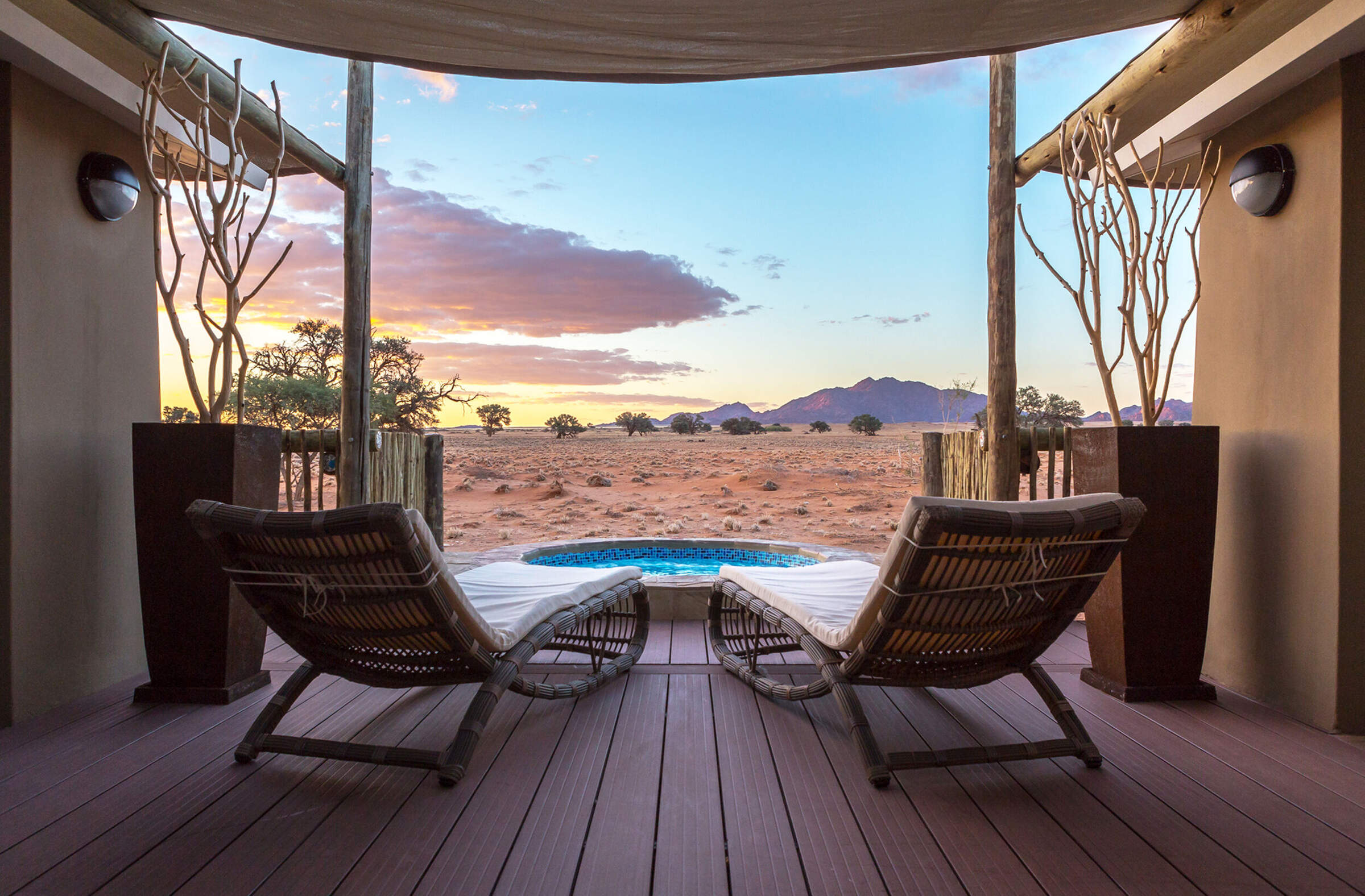
Sossusvlei Lodge
"Good base for exploring the vleis"
We enjoyed our two buffet-style dinners, eaten under the stars on the lodge's large open-air dining patio. On our second evening, I was tempted by the mussels on offer as a starter, my greed suppressing doubts as to their provenance in this relatively remote area, some 200 miles from the sea. They were delicious, as was the remainder of the meal, but that night I came down with diarrhoea, followed by stomach gripes which lasted some 36 hours.
For our first morning, we had decided to make an early entrance to the Park, in order to avoid dune-climbing in the heat of the day. The lodge – catering as it does essentially for Park visitors– offered a helpfully early and full breakfast. After eating, we joined the queue of vehicles at the Park Gate, awaiting the latter's opening at sunrise (approx 7am while we were there). The entrance system was pleasantly efficient. An attendant came down the line to log details of each vehicle. When the gate opened, all were free to drive in, paying the entrance fee only on return to the Ticket Office (some 100m inside the gate) when exiting the park later in the day. This meant that the entire queue was able to clear the gate and to proceed into the Park within minutes of its opening.
We drove to the end of the tarmac road (some 60 kms), where we transferred from our saloon car to one of the several 4x4 shuttles for the remaining 5 kms of sandy track to Deadvlei and Sossusvlei. The shuttles ply back and forth between car park and the vleis. In theory, having paid the fare, one can jump off and on any shuttle at any of the regular stops. In practice, we found that each driver tended to make arrangements to return at pre-arranged times and if, as seemed common, his initial party continued to re-occupy that shuttle, there was little or no room for “extras”.
We found that the time of one hour suggested by the driver for our walk from the shuttle track to Deadvlei (and back, for pre-arranged pick-up) was shorter than we would have liked for a full experience. Subsequently, at Sossusvlei (where the track gets much closer to the vlei), our driver suggested a 45 minute interval to climb the neighbouring dune and to have a good look around – but we extended this to 75 minutes. As it turned out, the driver's estimate was not unreasonable for a flying visit, but we were happy with our decision. It allowed us to sit on top of the dune for a good 10 minutes, taking in the spectacular scenery then, on descent, to circumnavigate at leisure the pan (with its tantalizing “designer” trails in the sand, animal tracks in the dried mud and flamingo and ducks in the remaining water).
Use of the shuttles may be avoided by choosing to walk, by driving oneself in a 4x4 or by joining a party drive organized from the lodge. However, the walk, on loose, shifting sand, is disproportionately tiring and time-consuming, without (so far as we could tell) any pleasant, offsetting experience. Those who choose instead to rely on their own 4x4 vehicle may not find this decision advantageous. Soon after we had first set off in our shuttle, we came across a stranded 4x4 rental, which needed help from the shuttle operators to regain firmer ground – whereupon its occupants decided to transfer to the shuttle. Our driver said that this was a common occurrence.
We were back at the lodge by around 2pm, where we rested on our porch, checked out the watering hole and took in the views from the top of the lodge's water-tower. Around 4.30pm we returned to the Park (the entrance fee being valid for multiple entries between sunrise and sunset), in order to visit Sesriem Canyon, some 15 minutes drive from the lodge. With the sun low in the sky, but shining along the main direction of the narrow, creviced chasm, there were memorable views from both rim and base."
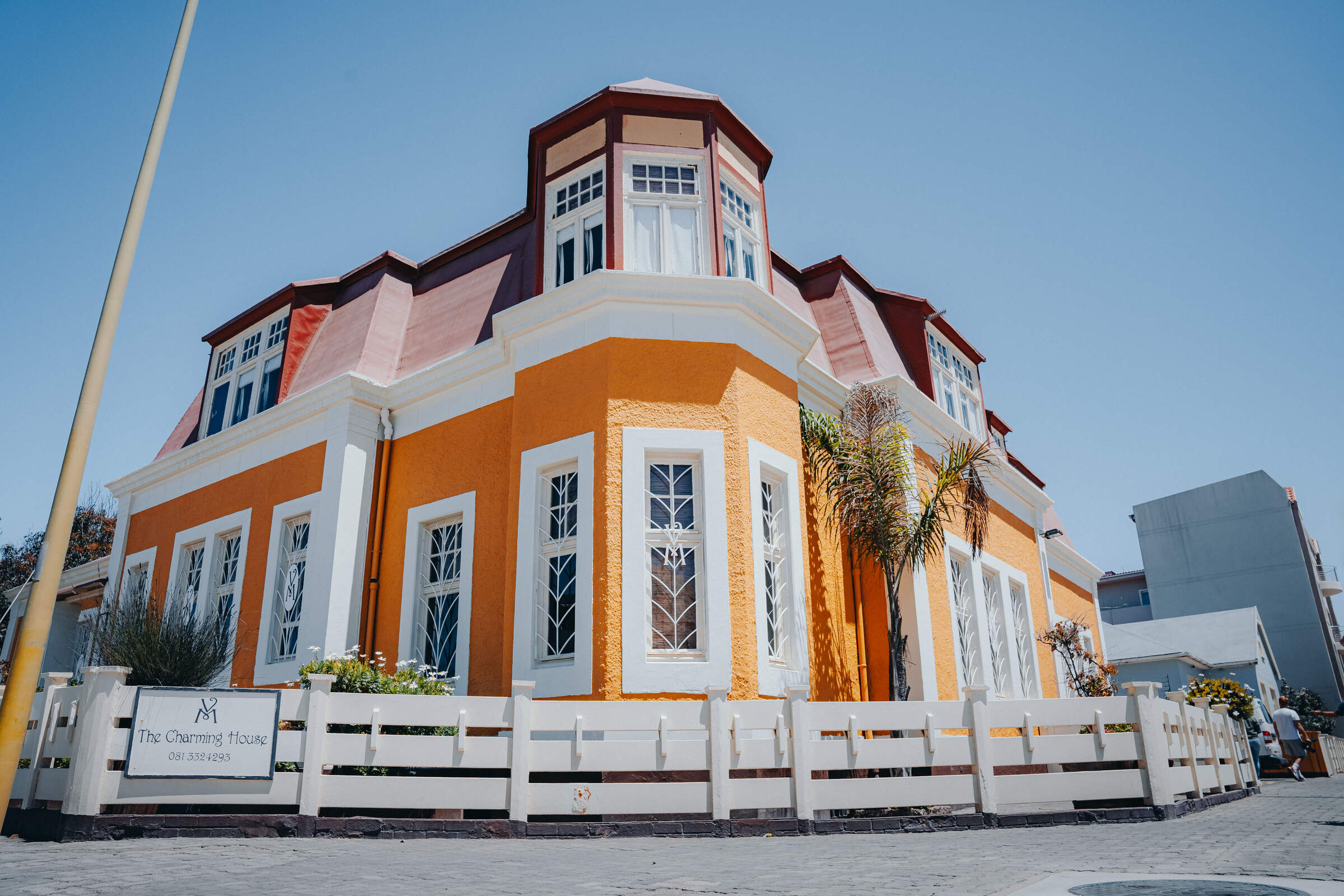
Villa Margherita
"Good, bad and ugly at Villa Margherita"
Villa Margherita is an old colonial house converted into a hotel with some charm, about 5 minutes walk from the town centre. We were allocated the “King” room - an enormous, generally well-equipped suite, which comprised a spacious en-suite double bedroom (though rather dimly lit), a second double bedroom and an adjoining lounge. Neither of the latter two rooms were needed or used by us, but we appreciated the gesture. There were other bedrooms within the main house, but we gained the impression that most fellow guests were using the more compact, modern rooms available in a recently built detached wing in the pleasant back garden. The hotel had been well modernized, providing, for example, free internet access to its guests, but, curiously, as described below, only rudimentary telephone facilities.
The hotel supervisor was welcoming. She turned out to be good with routine affairs, but either unimaginative or over-constrained by process when it came to matters of initiative. We gained our first inkling of this when we discussed our need to depart early on our first morning, in order to reach a kayaking rendezvous at Walvis Bay by 7.30am. She gave us to understand that it was impossible for us to take breakfast before 7am – even if this involved only cereal or other non-cooked food. We were not even offered a cold take-out. In the event, we took a chance, went down to the breakfast room at 6.45am and found a serving maid able to provide us with bread-rolls and a hot drink, which we bolted down before setting off at 7am.
We had a delightful day, kayaking among seals and dolphins in the morning, followed by an excursion to Sandwich Harbour in the afternoon. On our way back to the hotel from Walvis Bay, we stopped to take a look at Bird Island (a large artificial platform for collecting guano from resident pelicans, flamingo, seagulls and other birds.) This necessitated leaving the car unattended at a lonely parking area just above the beach, some 100m off the main road to Swakopmund. Our guard was down and we committed the cardinal sin of leaving our rucksack in the passenger compartment of the locked car. On return within 10 minutes, we found a rear window smashed and our belongings stolen. (We later learned that this location was notorious for such crime - with perpetrators hiding in the nearby dunes to await their opportunity).
Back at the hotel, minus ready cash and stolen cellphone, we needed phone facilities to report the car damage to the car-hire firm and to stop our stolen credit/debit cards. Our room had no telephone and we asked if we could use the hotel equipment to report our problems. The supervisor took us to a phone in the dining room, where we had to carry out the calls in the hearing of some dozen hotel-guests eating their dinner (an experience perhaps as irritating or uncomfortable for them as it was for us). She went off, but soon returned to hover over us with a long face and a silent wringing of hands – concerned, as it turned out, that we were making unexpected calls to the UK card companies, which she would have to account for. We reassured her, on completing our conversations, that we would pay for the calls, whereupon she left beaming. Subsequently, we were charged N$225, at N$15 per minute – the latter justifiable, perhaps, if the hotel had invested in a convenient phone system for its guests, but substantially over-priced when compared to the overseas call rates and relative privacy of public call-boxes just down the street.
Our experience of dining at the hotel was limited, though our second breakfast was fine. For our first evening we found that one had to choose from the dinner menu several hours in advance, in order (we were told) that fresh ingredients could be purchased. On this basis, Anni had an unremarkable vegetarian meal. I was still dealing with the mussels from Sossusvlei (discussed elsewhere), so ordered nothing and ate little. For our second evening, reluctant to engage with the choose-in-advance system and, in any case, tired with our experience of the dining room and its phone, we crossed the road to eat tasty, very reasonably priced food at a nearby Mexican restaurant, named Three Namigos."
With regards to the early breakfast, staff at the hotel cannot work earlier than 06:30 since no taxis operate before then and the manager does not want the girls walking to work alone from the township. Therefore no staff are available for a 06:30 breakfast, but if guests wish to eat something slightly before 7, the hotel will do what they can to help.
Villa Margherita decided a while back not to have phones in the rooms, mainly due to the cost, but also because most travellers have a mobile with them. They therefore provide cordless phones and free internet, where guests are welcome to use skype.
Villa Margherita are sorry that the guests were not so keen on their food. The hotel buys their food freshly each day and so guests must order in advance. If they prefer, there is a choice of many restaurants within easy walking distance.
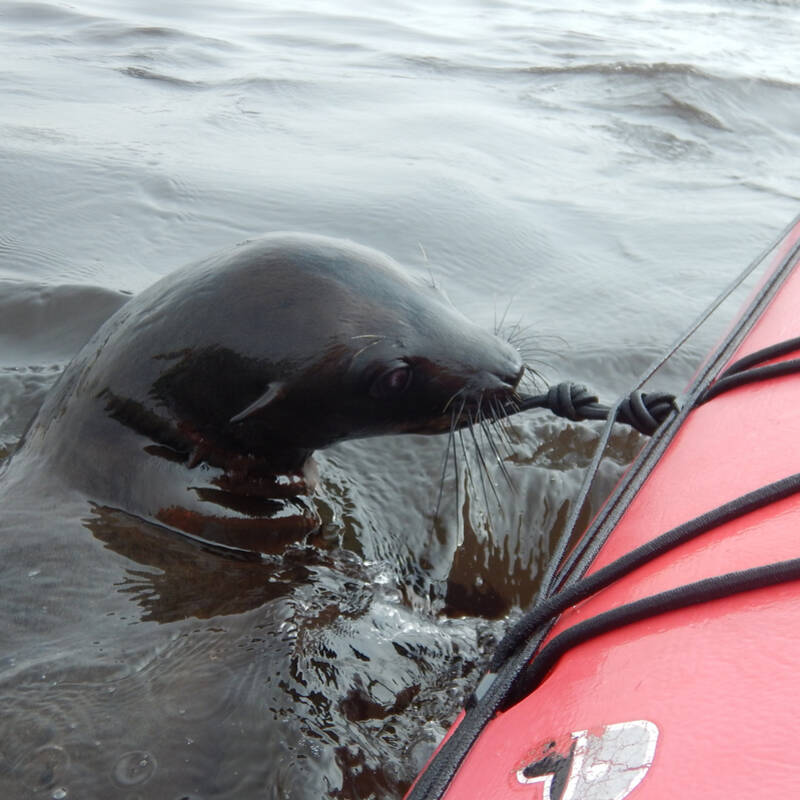
Kayaking with seals
"Great fun among the cavorting seals"
11 Sep 2012 • Morning excursion
Stopping near the end of Pelican Point we were each kitted out with waterproof jacket, trousers, shoes and camera-bag, woolly hat and flotation jacket. We were launched in double-kayaks into the bay (sheltered from open sea by the Point and - so Jeanne took care to assure us - shark-free). The cavorting seals were obviously used to such visits and immediately incorporated us into their jinks. Some took great pleasure in drenching us - shooting out of the water in skilfully executed corkscrew flips to smack the surface at us with their tail-flippers.
We were not used to kayaking but, in common with the other couples, found it easy to manoeuvre the light boats. Jeanne and her partner buzzed around us in single kayaks, giving directions and guidance. We visited three separate groups of seals frolicking in the water, against a background of sustained honking and barking from the large colony sun-bathing on the beach. As we neared the rougher water outside the Point we had two or three brief encounters with bottle-nosed dolphins, busy in their flight from pursuing boats of dolphin-watchers.
From time to time, Jeanne produced a camera and took a series of stills and movie shots of each couple. Later she obtained our email addresses and sent all concerned the pictures of their escapades. We thought that this might enable us to settle a debate as to which of Anni and I was most guilty of sneaky rests from paddling – but, alas, the issue is still unresolved.
After two enjoyable hours on the water we returned to the 4x4, where Jeanne broke out snacks and drinks. We had to cut short our guzzling, because at this stage in the proceedings our next host arrived at Pelican Point in his Landrover, ready to take Anni and I on to Sandwich Harbour. We bid Jeanne and the others goodbye and left with fond memories of a very pleasant excursion.
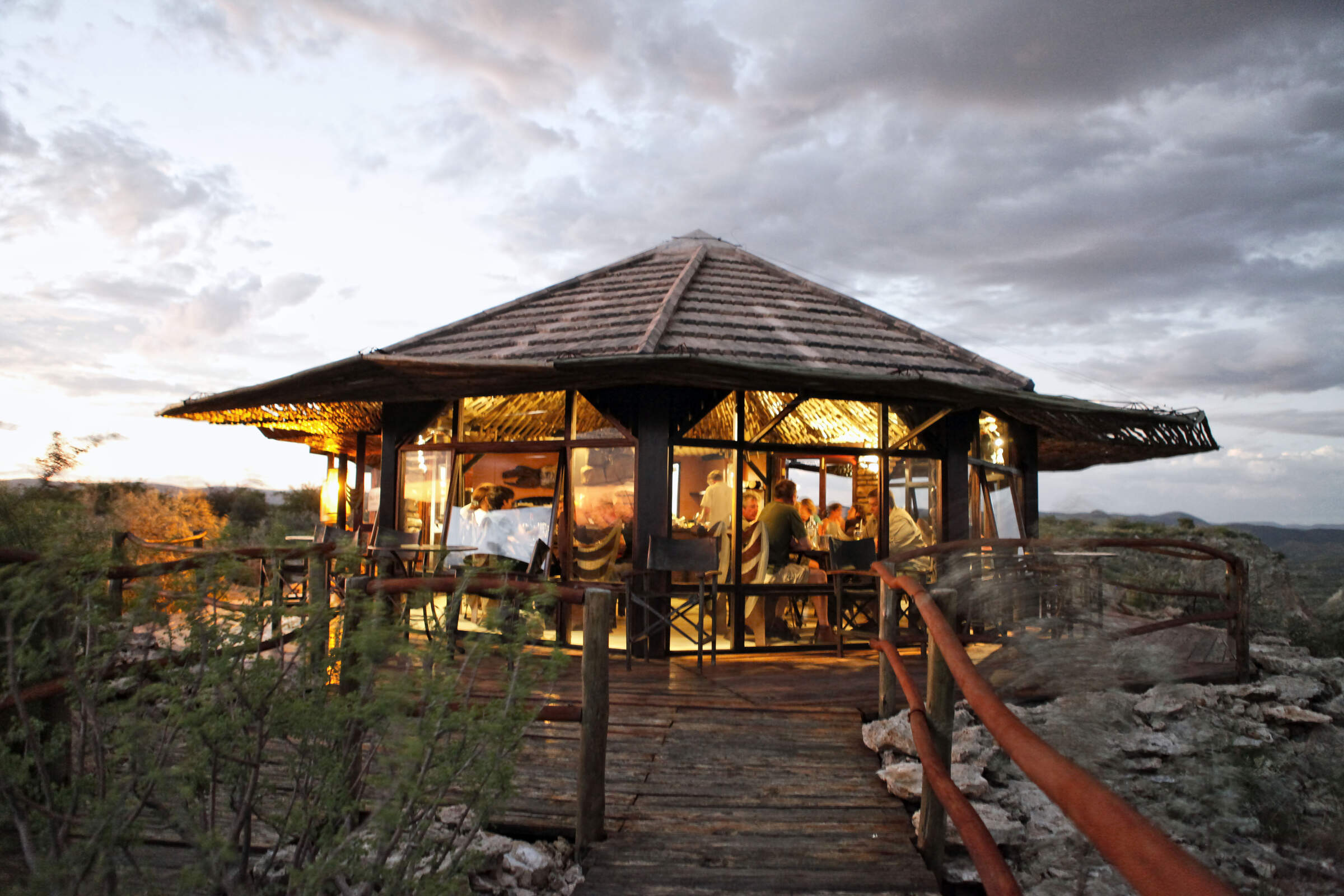
Vingerklip Lodge
"Great stopover amid the Ugab Terraces"
For dinner we had opted to dine in the Eagle's Nest restaurant, some 1000 feet above, upon the magnificent Ugap terrace prominence which towers over the lodge. The climb involved a 15 minute walk up a track, culminating in the ascent of several flights of an enclosed metal staircase, bolted on to the side of the sheer cliff (strangely invisible from any distance). Food and drink were transportable up a cable-trolley system on the other side of the narrow bluff. The views as the sun set, the guests quaffed and the chef barbecued were magnificent. There were, however, some empty tables: most guests had remained below to dine in the lodge's main restaurant. Perhaps they were put off by the climb (and return in the dark, down the lantern-lit path) or by the more restricted range of food (essentially barbecued kudu, springbok and beef, with soup starter, vegetable side-dishes and fruit salad, plus alcohol and other drinks). Nevertheless, even Anni, a vegetarian, thought we had made the right choice – at least for a once-off experience.
The next morning, before breakfast, we walked to the nearby Vingerclip Monument (clearly visible from the lodge and located on the same property of land). We reached this impressive granite pillar, climbed to its base and watched it turn from purple to a ruddy orange, as the sun rose from behind the Eastern escarpment. On the plain below, to the West, there appeared the giant shadow of the rocky finger, reaching at least one kilometre in length.
After breakfast we checked out and detoured some 5 kms south, in order to visit a farm advertised at the lodge. Here we were entertained by the farmer, Heinrich (who somehow evoked Crocodile Dundee – albeit young, wearing a baseball cap and toting a loaded cartridge-belt and gun). For N$ 175 per person he gave us a two hour excursion around his cattle farm (with its sideline hobby of thoroughbred horses). We had been expecting to walk, but instead he chose to drive us slowly in his farm truck, sjambok at the ready, to the main attraction – some old, but well-preserved bushmen's paintings located on the side of a rocky knoll. The paintings were discovered by his grandfather and authenticated and dated via an independent university study. He also showed us a collection of bushmen artifacts (including grain-grinding utensils) subsequently excavated nearby. We found the monotone but knowledgeable Heinrich to be a fount of local history, and we greatly enjoyed this unplanned detour."

Dolomite Camp
"Stopover in Etosha, with a difference"
The climate-controlled chalets are cleverly designed, partly on stilts (to counter the slope of the ridge). The main bed area of our chalet looked out over the plain through panoramic windows, across a narrow verandah with seating. It was modern, comfortable and well-equipped (for example with telephone to the main lodge, fridge, kettle, tea/coffee facilities and luxuriously (or wastefully) large shower-heads in the ensuite wash-room at the back).
We were lucky to be allocated a chalet at the Northeastern end of the ridge, with a decent view of activities at the waterhole. It was fun to sup wine on the verandah, watch the waterhole and to locate animals elsewhere on the plain through binoculars. Facing East as we were, there was a spectacular dawn in the morning, watched in the company of dassies (rock-hyrax) on the boulders behind the chalet.
Our chalet location also resulted in a fairly long trek along the central walkway, up the hump of the ridge, then down, to reach the restaurant and bar area. Because there is no perimeter fence to keep out animals, guests wishing to use the walkway after sunset are requested to telephone for a shuttle (also used to chug guests and luggage to and from the car park at the Southwestern foot of the ridge).
For dining, we were directed to one of the two restaurants (we never learned whether there was any distinction of food or style). Most of the seating here was concentrated around a communal dining table, where we enjoyed a reasonable dinner (from a three course set menu, with choice from 3 or 4 main courses), attentive waiter service and conversations with the cheerful, younger, multilingual Swiss and German fellow-guests around us.
We were able to settle our food and drink bill by credit card - but only on the fourth attempt. The guest in front of us had given up, in impatience, and paid with cash. As the service-maid charmingly put it to us: "Our telephone line is unwell today!"
Overall, our stopover at Dolomite (en route from Galton gate, towards Etosha East) was very pleasant. It enabled us to experience Etosha West, which provided some excellent chance encounters, both on the road and at some of the waterholes, visited as we drove towards the lodge (there was, by the way, no petrol station at the lodge or at Galton Gate, so travelers coming from the South and going our way should consider topping up at Kamanjab). However, we found the game-viewing experience, generally, to be less intense than that in Etosha East - and the viewing at the lodge is limited by the positioning of the waterhole and the absence of floodlights thereon. The contrast was well worth the experience, but we were content with just a one night stay."
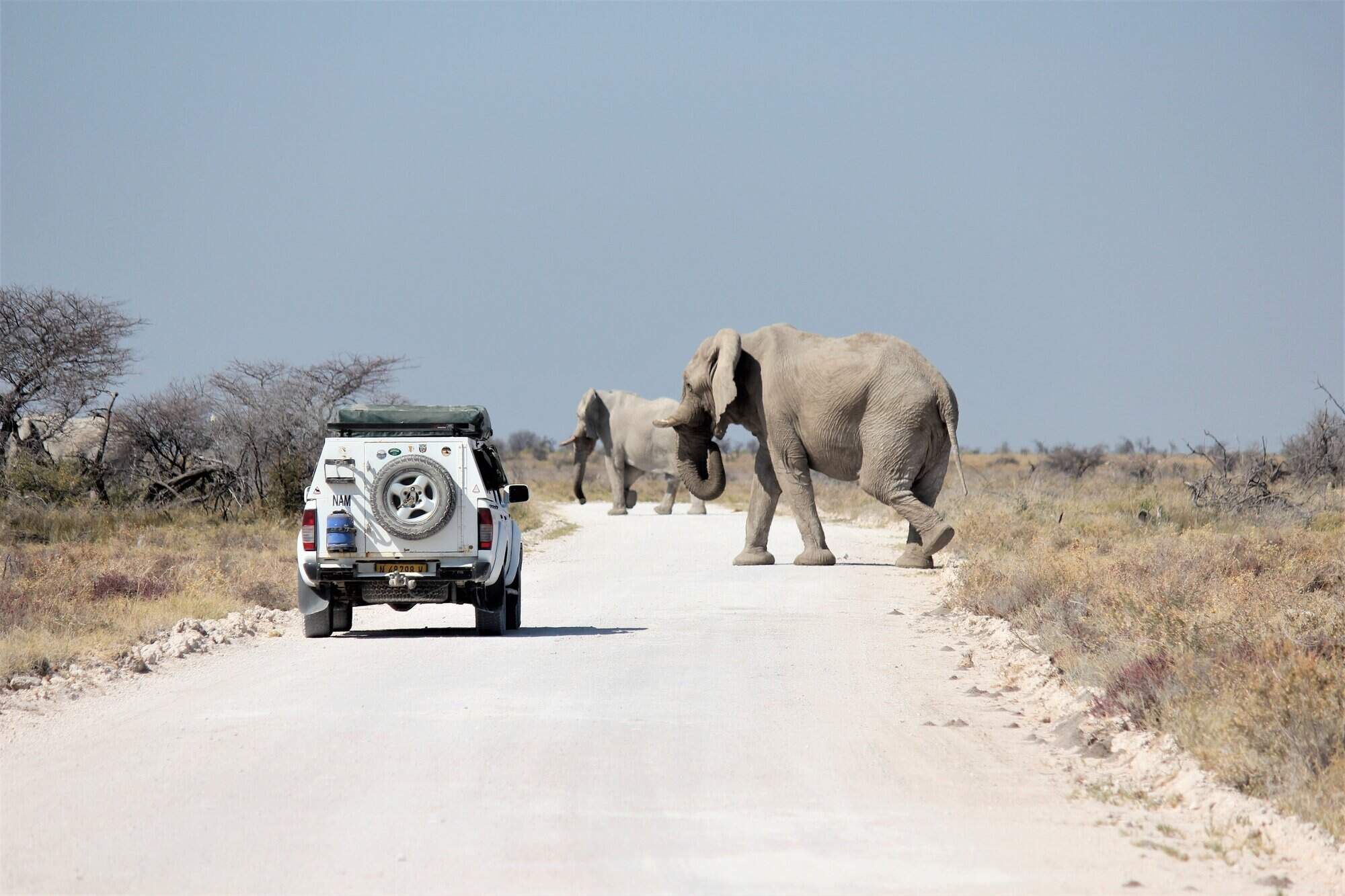
Okaukuejo Camp
"Beastly evenings at Okaukuejo"
On checking in at Reception (and uniquely among our Namibian lodgings), we were required to deposit N$ 500 in bank-notes, retained by the office. We were told that this was to ensure return of the chalet key as well as to provide security against damage. However, there was no procedure to verify the condition and contents of the chalet at any time during our stay (though there was a note in the chalet manual asking guests to notify any damage noticed on first entry) and we received the bank-notes back in full without any enquiry, once we had surrendered the key on checking out.
We were allocated an air-conditioned bush chalet, well located for access to the waterhole spectating area, some 80m away. It was clean, comfortable and quiet. It provided a large ensuite bedroom/lounge, a kitchenette (without utensils but with fridge and kettle), porch and external barbecue grill. Basic barbecuing equipment, plus vegetable matter and meat were on sale in the shop – but plastic cutlery only. We were not tempted, though we saw and smelled some successful efforts at neighbouring chalets, whose occupants, however, appeared to have brought their own food and equipment.
The jewel in its crown and the main reason for staying at the camp is its waterhole. There is also the convenience of being inside the park, allowing maximum excursion time between the permitted driving hours, from sunset to sundown. On each of our two nights, after-dinner viewing at the floodlit waterhole (only some 30m from spectators on its nearer side) was magical. The “stage” was hardly ever empty. A large cast showed up - even a leopard on our second evening – and there were unusual antics from rhinos, elephant and giraffe. Lions roared loudly during the night, but we saw such cats only at another waterhole, some 20kms from the lodge.
Dinner arrangements were rather cumbersome and we found dining conditions to be unpredictable or chaotic. Guests wishing to dine are required to register each day. We first spotted the registration sheet by chance, as we checked in at Reception. On our first evening (a Saturday), we entered the dining area from the direction of our chalet and stood there, ignored by all the over-worked waiters. We eventually discovered that, by entering from the direction of Reception, we would encounter a head-waiter, who would tick our reservation on his list and inform us of our pre-allocated table number. On that first visit, under stress from a longish queue, he waved us vaguely in the direction of our table, which we then had difficulty in locating because the numbering on the tables was only partly sequential (on our second visit he allocated us a wine-waitress, who took us to our table).
The choice and quality of the buffet-style offerings were good. Each dinner was charged at a very reasonable fixed rate of N$ 170 per person, to cover all courses. On our first night there were queues (some long) at all the serving counters and it was difficult to attract the attention of the wine-waiter. At the end of our meal we committed a faux-pas by leaving without paying for the food and drink – the wine waiter was unobtainable for us to sign anything, and we thought, erroneously, that all charges would automatically go on to our chalet account. Subsequently, we discovered that both food and drink charges at dinner must be settled on each visit and independently of any chalet account. All, however, was resolved amicably on our second evening when we paid the bills for both visits. We also found the place much less crowded on that evening (though we were there at roughly the same time of day) – and the whole experience was much more pleasant."
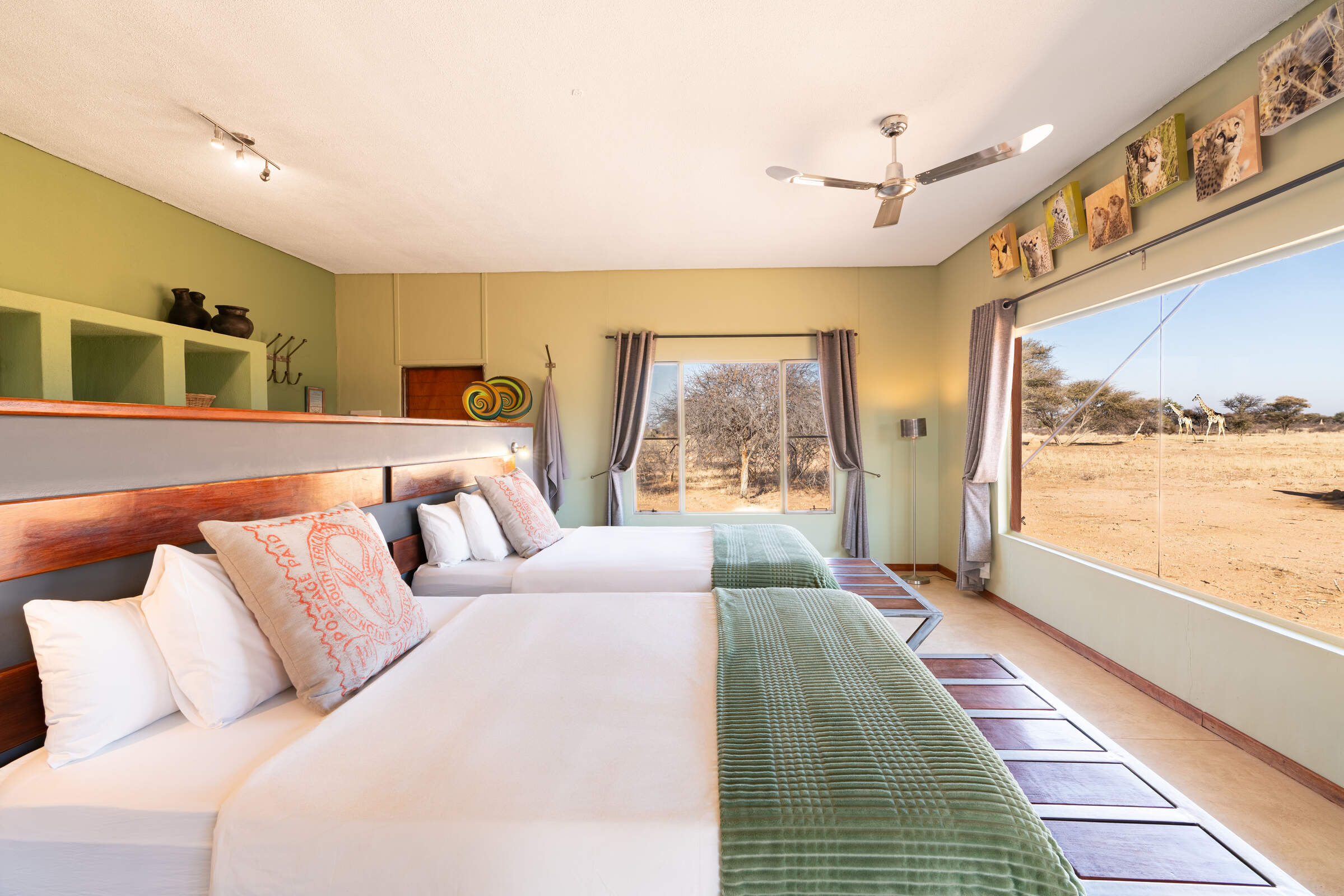
Okonjima Plains Camp
"Cats' whiskers at Okonjima"
We were upgraded to a “View” chalet - spacious, with two double beds, panoramic windows, table and chairs, superior en-suite facilities and a porch looking at the adjacent patch of veld and its grazing warthogs. With a tin roof, the interior became hot as the day wore on. The internal electric fans were sufficient to relieve while we were there (in Spring), but the chalet might, we thought, become uncomfortable in Summer. During our second evening one of the beds was visited by some small ants so we transferred to the other.
On arrival, we were given an introduction to the facilities by one of the staff. She spoke engagingly, but obviously thought that we knew more of the Camp's style and its activities than we did. We felt as though we were being pushed into “activities”, whose agendas were not apparent to us. When we asked as to the latter, she said that our “guide” would decide – not very illuminating at the time, though she did say there would be either cheetah and leopard tracking, at the discretion of the guide. We would have preferred to have been provided with a written outline of the Camp's programmes and the modus operandi (with, by all means, a supplementary talk to bring it all to life).
As it turned out, we enjoyed it all. We found that we were, in effect, allocated a guide and personal sponsor for our stay. He ascertained our preferences and made arrangements accordingly. Normally, these entailed joining an excursion which he would lead (for which one would be billed on account – unless there under an all-inclusive tariff). A side-effect of this approach was that we were seated with other members of our excursion parties at dinner. We got on well with these fellow-guests and we enjoyed the company. We presumed – but never checked - that we could vary the seating arrangements, had this not been the case.
Our first “activity” started at around 4pm on the day of our arrival. It was a tour by 4WD shuttle of the AfriCat facilities, including the large enclosures for certain orphaned cheetah, leopard and caracal. While interesting – and an eye-opener for anyone who had not previously seen such cats – it was not, in our opinion the best activity available.
The next day we went on a leopard “hunt” after breakfast and a cheetah “hunt” around 4pm (after complimentary tea and cakes). Each excursion lasted approximately 3 hours, giving us the middle of the day to relax and to do our own thing (we initially contemplated one of the self-guided hikes at this time - but it was too hot for us). Our guide drove our parties of 4-6 persons in 4WD shuttles (with capacity for 8 guests) around the much larger expanse of Okonjima's bush terrain. Here roamed the cats and other wildlife, constrained only by many miles of outer perimeter fencing, encompassing hills, ridges and plains.
The cats were collared and traceable through radio receivers deployed by our guide. In this respect there was a degree of artificiality. However, the imprecision of the tracing equipment, the density of much of the bush, the off-roading and the distances involved combined to provide real prospects of failure and a thrill of hunt.
We were lucky. On our morning excursion, after much double-backing and circling through the thick bush, we tracked down a leopard still eating a fresh kill – a steenbok which she had dragged up a tree. In the afternoon, we quickly located a lone cheetah, loftily surveying its surrounds from a termite mound. Then, after a couple of hours (during which we saw giraffe and other plains-game, but no cats), we ran to ground three cheetah who had freshly killed a young zebra. Initially, all three cats stayed together at the kill. However, the routine changed as we watched. As one ate, the other two moved off a small distance to peer intently in another direction – prepared, as it turned out, to fend off the attentions of an approaching leopard who had smelled the kill.
In normal circumstances guests are permitted to disembark the shuttle in order to get closer to cheetah (but not leopard). In this case we were forced to get back into the vehicle hastily, after we heard the cough of the encroaching leopard and our guide was radioed by a colleague (who was tracking the leopard for his party from Okonjima Bush Camp). We found that the guides confer and collaborate during their respective excursions, in order to share discoveries and to improve the experiences of their parties. They were careful to avoid crowding. Thus, after we had finished with watching the three cheetah, we moved on to see the frustrated leopard (some 60m away through the bush, in the gathering dusk), while the party from Bush Camp moved from their primary “target” to view the cheetah.
On each evening, after a satisfying dinner, we opted to join a party to walk some 15 minutes via torchlight to the Camp's porcupine hide. Here the guide tossed down a basketful of vegetable remains into a floodlit area outside the hide, in order to lure the animals. On the first evening nothing showed up, except a jackal which quickly took fright and fled. A German guest asked if the porcupines existed. She had done the walk twice the previous year and this was the third occasion on which she had drawn a blank. However, the next night we went again (German girl too) and, within minutes, two large porcupines emerged from the bush to chomp their way steadily through the assorted chunks and peelings on offer."


Unfortunately .... we used the room safe (operated via customer-set pin-code) to store our valuables, including an Expert Africa travel wallet containing cash and other documents. On first retrieval of the wallet, I immediately felt that that the internal arrangement of its contents was not as I had left it. I quickly ascertained that all the pound sterling notes were intact - as were various travel documents. There remained a wad of South African Rand, which, foolishly, I checked only superficially (the wad was thick, like me, for reasons I explain below) and I dismissed my fears.
A few days later and many miles away, I counted our rand (in preparation for expected exchange control forms on leaving for Namibia - though in the event such controls never materialized) and found that we were 3-4000 short. We realized that, because we had received the initial 10,000 rand in denominations of 200 down to 10, it would have been relatively easy to skim off a third of the value, while diminishing the thickness of the wad only marginally. Since our stay at Oceans Eleven, the wallet had remained in our undisturbed possession or in room safes - and never, other than during our stay at that hotel, did we have the feeling that it had been interfered with.
I offer the following, probably obvious, tips.
(1) Make sure you control the mix and portability of your holiday cash (I had expected a wad thin enough to carry on our persons - but had no say in this, because I had ordered the rand via a mail delivery service).
(2) Do not trust hotel room safes - for obvious reasons, they can all be opened by hotel management, and it cannot be hard for service staff to become aware of emergency access arrangements.
(3) Count all your cash immediately, no matter how tedious, should you feel there is something different about what you had left in the safe.
(4) Consider keeping your valuables in the locked boot of your car and retain the car key on your person (although many travel insurance policies will not cover you from night loss in such circumstances - whereas they do normally cover theft, within limits, from room safes)."